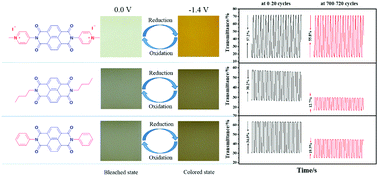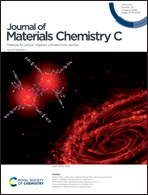Energy-saving and long-life electrochromic materials of naphthalene diimide-cored pyridinium salts†
Abstract
Developing electrochromic materials with energy-saving (i.e., low driving voltage) and long-life (i.e., high switching stability) properties is highly desirable with respect to practical application. In this work, we report the synthesis of two N,N′-di(4-pyridyl)-1,4,5,8-naphthalene diimide derivatives (DPNDIs), (Me2DPNDI)·(2I) and (benzyl2DPNDI)·(2Br), and the characterization of their electrochemical and electrochromic properties. Both DPNDIs showed two quasi-reversible redox couples in the cyclic voltammograms with cathodic peak potentials of approximately −0.30 and −0.70 V vs. Ag/Ag+. The electrochromic devices based on ((Me2DPNDI)·(2I) and (benzyl2DPNDI)·(2Br)) gave a colored state of dark orange and orange, respectively, which are colored states that have rarely been reported, and both DPNDIs had a low onset bias of −0.7 V and good switching stabilities (the change in optical contrast after 7200 s of <4%). The introduction of pyridinium salts at the DPNDI core enhanced its solubility and switching stability. In combination with density functional theory (DFT) calculations, it was shown that the formation of pyridinium salts modified the electronic properties of 1,4,5,8-naphthalenetetracarboxylic dianhydride (NDA) and DPNDI, and both pyridinium salt and NDA units contributed to electrochemical reduction. The results demonstrate that (Me2DPNDI)·(2I) and (benzyl2DPNDI)·(2Br) are promising electrochromic materials and can be used in energy-saving buildings, smart windows, traffic signs, electronic paper, sunglasses, and anti-glare rearview mirrors.



 Please wait while we load your content...
Please wait while we load your content...